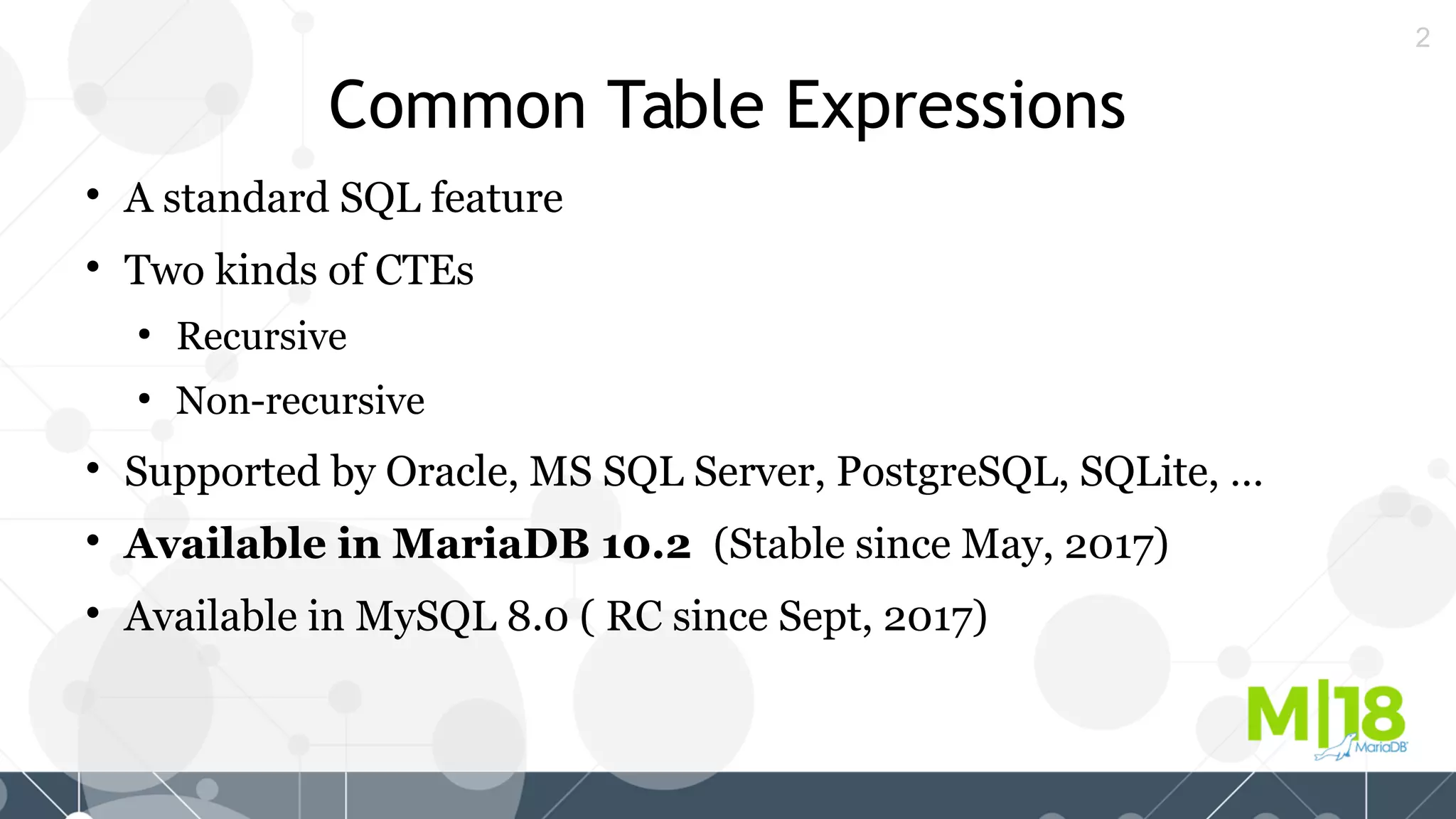Common Table Expressions (CTEs) allow for temporary query results to be stored and reused within the same SQL statement. There are two types of CTEs - non-recursive and recursive. Non-recursive CTEs can refer to other CTEs and are optimized by MariaDB through techniques like CTE merging and condition pushdown. Recursive CTEs enable querying recursive relationships and computing transitive closures through a recursive part that is executed repeatedly until it produces no new results.






















![23
Recursive part
Anchor part
Recursive use of CTE
“recursive”
Recursive CTE syntax
with recursive ancestors as (
select * from folks
where name = 'Alex'
union [all]
select f.*
from folks as f, ancestors AS a
where
f.id = a.father or f.id = a.mother
)
select * from ancestors;](https://image.slidesharecdn.com/session3-180306225452/75/M-18-Taking-Advantage-of-Common-Table-Expressions-23-2048.jpg)







![31
with recursive ancestors as (
select * from folks
where name = 'Alex'
union
select f.*
from folks as f, ancestors AS a
where
f.id = a.father or f.id = a.mother
)
select * from ancestors;
Result table
+------+--------------+--------+--------+
| id | name | father | mother |
+------+--------------+--------+--------+
| 100 | Alex | 20 | 30 |
| 20 | Dad | 10 | NULL |
| 30 | Mom | NULL | NULL |
| 10 | Grandpa Bill | NULL | NULL |
| 98 | Sister Amy | 20 | 30 |
+------+--------------+--------+--------+
+------+--------------+--------+--------+
| id | name | father | mother |
+------+--------------+--------+--------+
| 100 | Alex | 20 | 30 |
| 20 | Dad | 10 | NULL |
| 30 | Mom | NULL | NULL |
| 10 | Grandpa Bill | NULL | NULL |
+------+--------------+--------+--------+
Computation
●
Step #4: No [new] results
●
The process finishes.](https://image.slidesharecdn.com/session3-180306225452/75/M-18-Taking-Advantage-of-Common-Table-Expressions-31-2048.jpg)
![32
1. Compute anchor_part
2. Compute recursive_part
to get the new data
3. if (new data is non-empty)
goto 2;
with recursive R as (
select anchor_part
union [all]
select recursive_part
from R, …
)
select …
Summary so far](https://image.slidesharecdn.com/session3-180306225452/75/M-18-Taking-Advantage-of-Common-Table-Expressions-32-2048.jpg)















![48
with recursive R as (
select anchor_part
union [all]
select recursive_part
from R, …
)
select …
[Non-]linear recursion
The SQL standard requires
that recursion is linear:
recursive_part must refer to
R only once
No self-joins
Not from subqueries
Not from inner side of an
outer join
...](https://image.slidesharecdn.com/session3-180306225452/75/M-18-Taking-Advantage-of-Common-Table-Expressions-48-2048.jpg)

![50
with recursive R as (
select anchor_part
union [all]
select recursive_part
from R, …
)
select …
Linear recursion
New data is generated by “wave-front” elements
Contents of R are always growing](https://image.slidesharecdn.com/session3-180306225452/75/M-18-Taking-Advantage-of-Common-Table-Expressions-50-2048.jpg)









